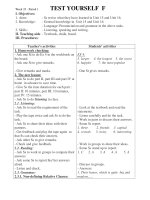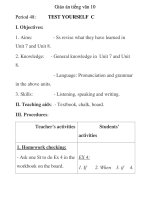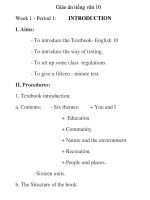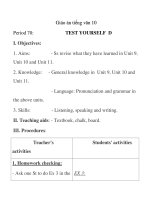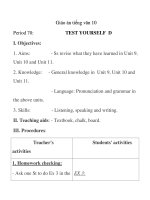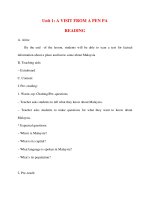Giáo án Tiếng Anh lớp 10: Unit7: Saving energy Lesson 2 : Speaking + Language Focus ppsx
Bạn đang xem bản rút gọn của tài liệu. Xem và tải ngay bản đầy đủ của tài liệu tại đây (67.29 KB, 6 trang )
Unit7: Saving energy
Lesson 2 : Speaking + Language Focus 3
A. Aims:
By the end of the lesson, students will be able to make and respond to
suggestion and practice talking in pair or in group
*Teaching aids:
Pictures, extra board
B. Content:
I. Pre
speaking:
1. Warm
up: Kim’s game
Watch/see and try to remember what happens to each picture?
*Key:
A.
A common faucet is on
B.
The gas fire is too high
C.
An electricty fan is on
D.
An air condition is on
E.
The T.V, a table lamp, alighting fixture and a neon tube are on
F.
(private) faucets are on in a bathroom/ faucets are on and the bathroom is
overflowing with water
G.
Two people are cycling (riding a bike) and two people are driving their
motorcycles
H.
Two people are waiting for a bus
2. Pre–teach (Revision):
Matching: English: Vietnamese:
Suggestion (n) treo mắc
Respond (v) thích hơn
Response (n) sửa chữa
Prefer (v) gợi ý
Good idea (n) đóng, gắn/ sửa chữa
Hang (v) đáp lại, phản ứng lại
Fix (v) ý kiến hay
3.Gap fill :
- Put the 7 gap –fill mini dialogue on the board.
a) A : ………………………. by bus to school? (Why don’t we go )
B: No, ……………… The bus is expensive. (I don’t want to)
b) A: …………………. The air conditioner when we aren’t in the room. (Let’s
turn off)
B : ………… (OK)
c) A : ………………. by bicycle instead of by motorbike? (Shall we go)
B : ………………. walk. (I prefer to)
d) A : …………… the faucet because we’re wasting a lot of water.(I suggest fixing)
B : …………………… (Let’s do that)
e) A : …… turning of the lights and TV when we aren’t using them? (How about
turning off)
B : ……………………. (That’s a good idea)
f) A : …………………… the faucet. (I think we should turn
off)
B : …………… (All right)
g) A : …………………… the fan to save energy ? (What about turning
down)
B : ……………… (Ok)
- Divide the class into 2 teams : Team A listen for the gaps in what A says and team
B listen for the gaps in what B says
- Read the dialogues aloud several times -> Ss listen and write down the words they
hear.
- Check ss’sanswers.
- Have students look at the suggestions and responses in the mini dialogues and
decide if the speaker agree or disagree with the suggestion.
a, Suggestions:
– I suggest + V-ing
–
How/ what about + V–ing
–
I think/suggest we should + V(bare)
–
Shall we + V(bare)?
–
Why don’t we / you + V(bare)
–
Let’s + V bare
b, Responses:
Ok/ All right.
That’s good idea.
Let’s do that.
No, I don’t want to….
I prefer to ….
Let’s….
II. While–speaking:
1. Making suggestions about how to save energy using the expressions and pictures
(P.59)
2. Pairwork/ groupwork
Practice suggesting (and responding) what they are doing to save energy (for
class)
Example:
A:
I think we should take a shower instead of bath
B:
That’s a good idea.
C:
Shall we make poster on energy savung and hang them around our school?
D:
Great! Let’s do that.
III. Post–speaking:
Making suggestions using the situation and ideas given (LF3, P.64):
(one table–one group; each gives one suggestion on turns)
a, Topic one: Your class wants to help the poor in the neighborhood of your school
*Key: I suggest collecting some money
collecting unused clothes
organizing a show to raise money
giving lessons to poor children
helping erderly people and war invalids with their chores
giving poor children books, notebooks and other school things…
b, Topic two: Your friend wants to improve his/her English . What do you
suggest …?
*Key: I suggest (that) you should:
–
work harder on your pronunciation
–
write sentences with new words
–
speak English in class
–
buy a good dictionary
–
do some reading every day
–
write diary in English
IV. Homework:
1.
Do exercise 3 (64) (Textbook)
2.
Find out new vocabulary in “LISTEN”
V.Teacher’s self-evaluation:


